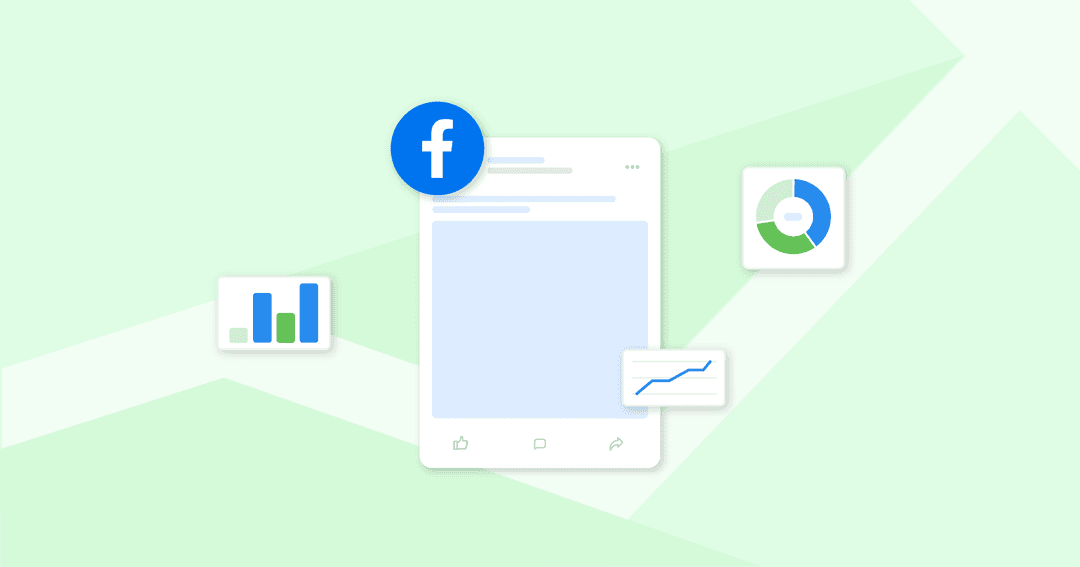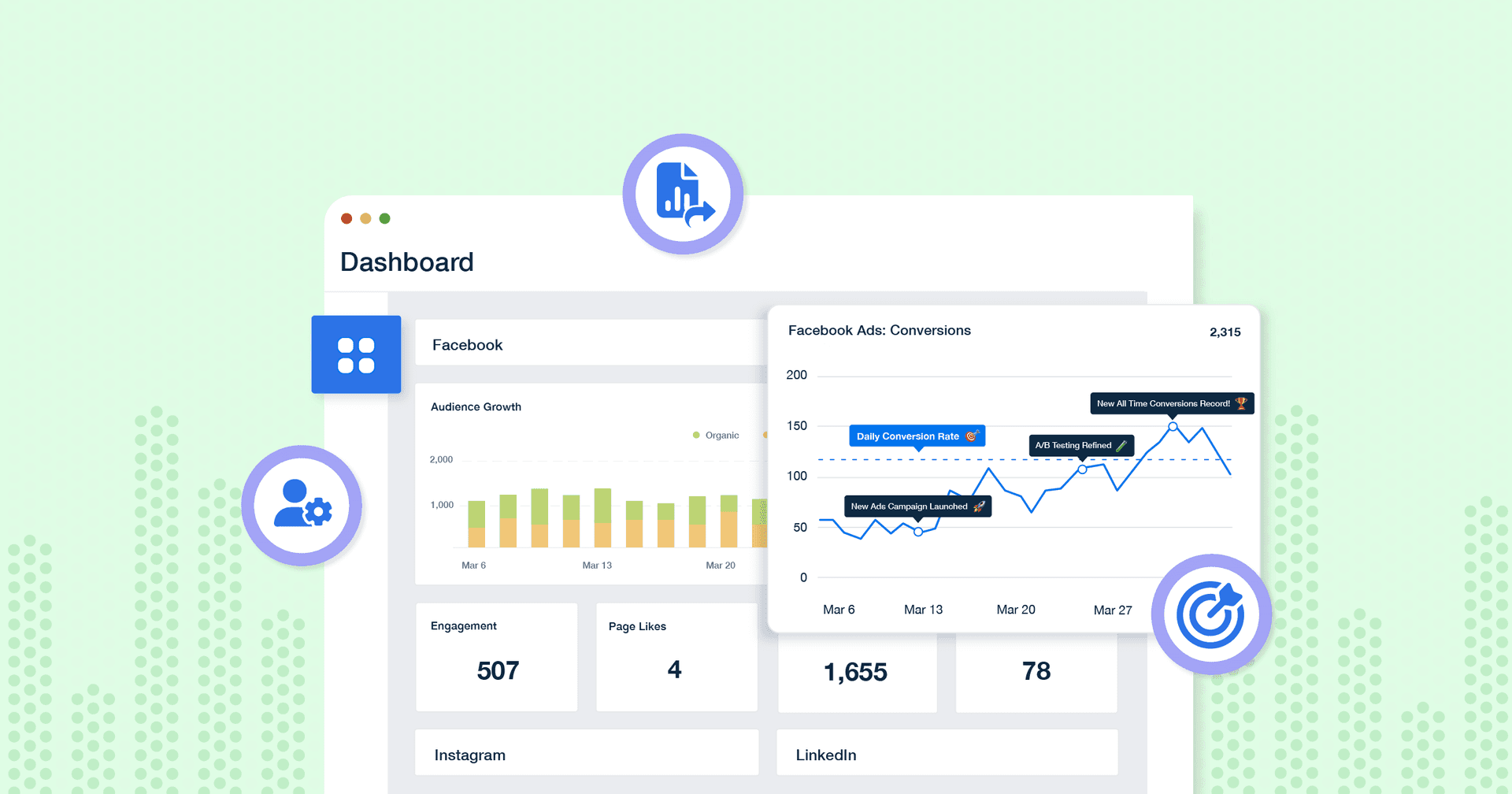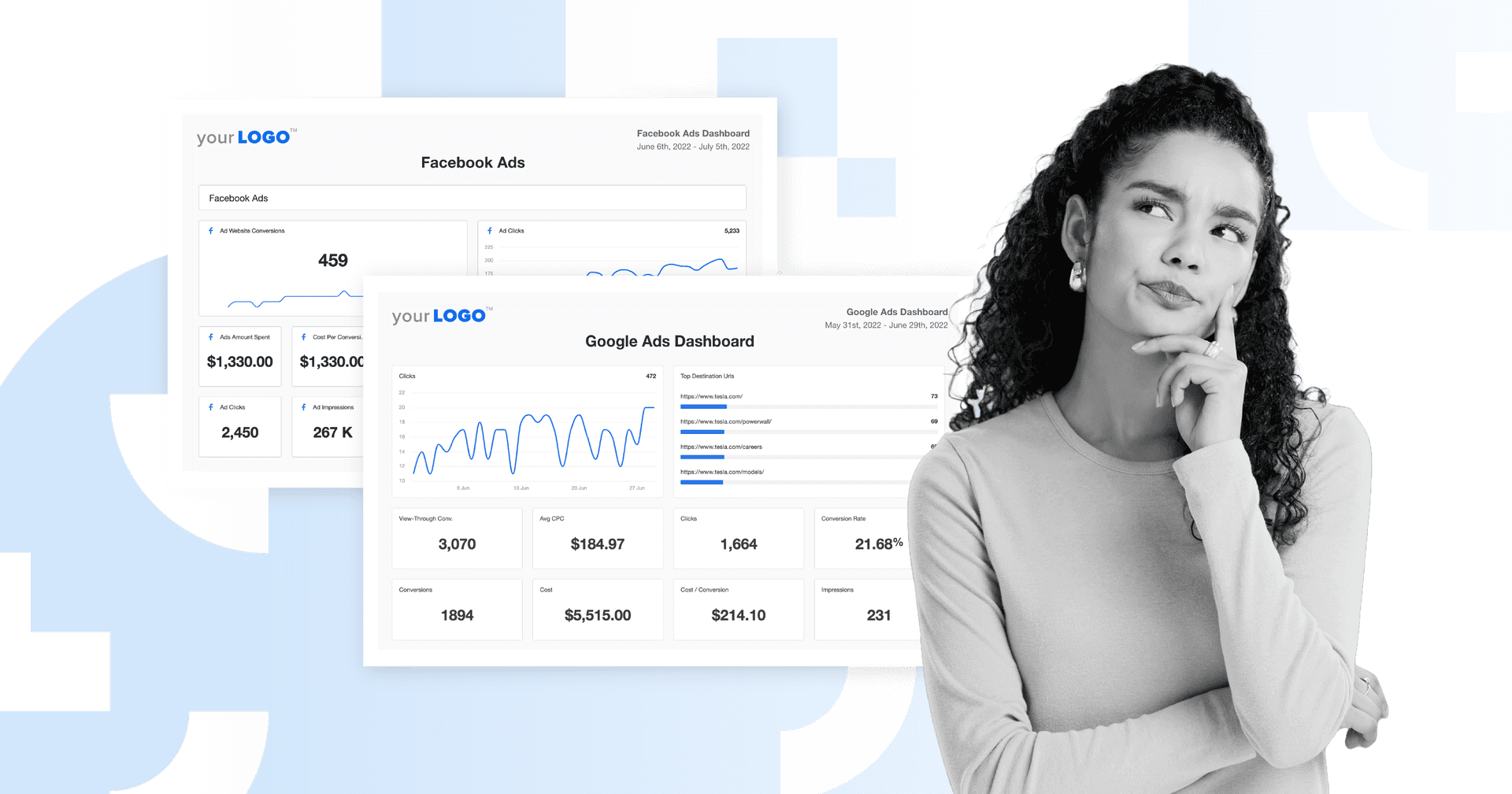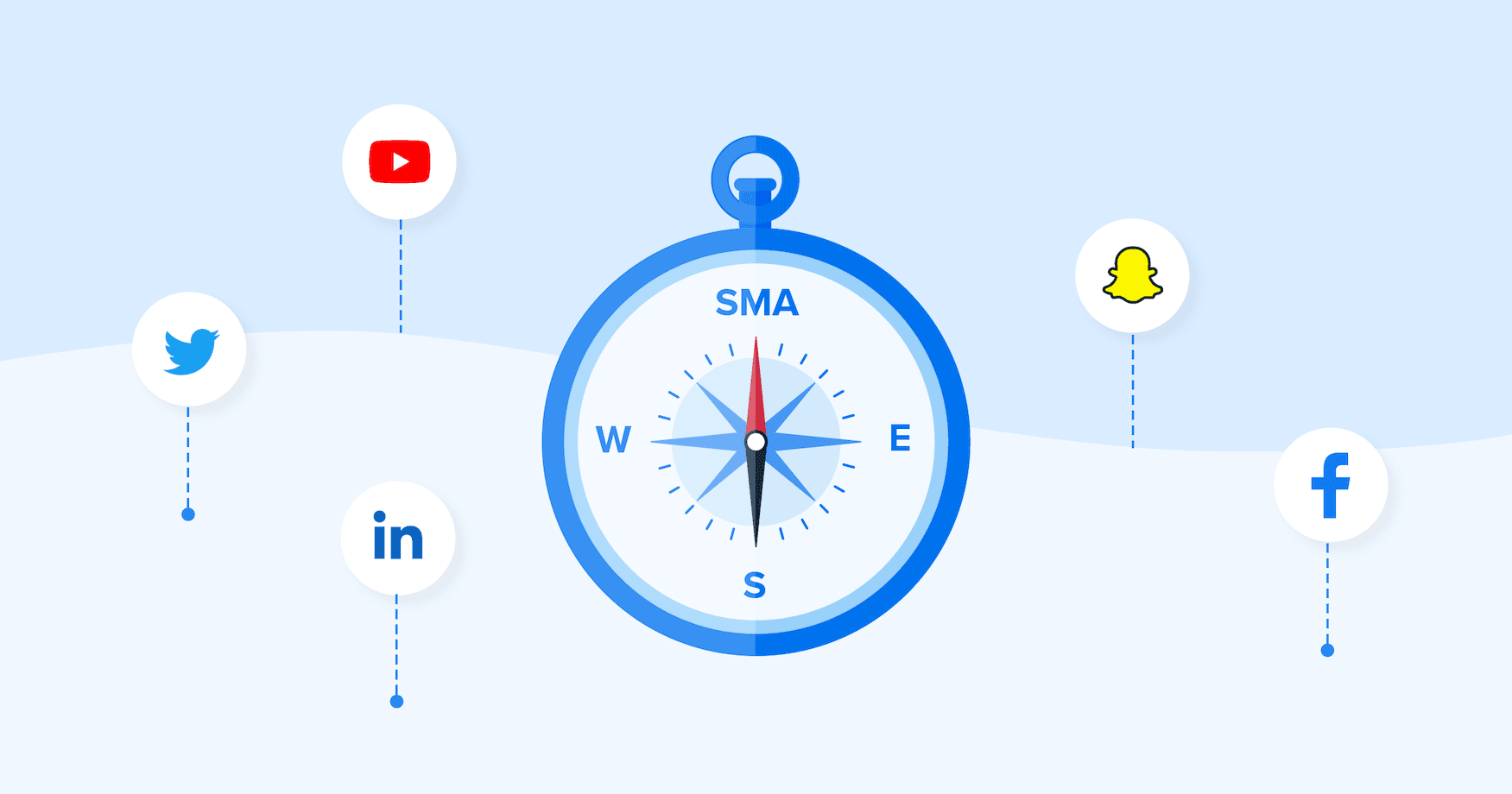Table of Contents
QUICK SUMMARY:
Facebook Ads metrics are quantitative measures used to assess the performance of advertising campaigns on the social media platform. These data points are used to evaluate audience engagement, track return on investment, inform decision-making, and refine ad strategies. This article focuses on the top Facebook Ads metrics to track, what they mean, and how to use them for campaign optimization.
Tracking and reporting your Facebook Ads metrics is an essential part of any Facebook campaigns. Both you and your clients want to know:
Which ads have the best CTR and CPC (Cost Per Click)? How much have you spent? What is the campaign’s overall ROAS?
A great Facebook Ads report should answer each of these questions, and more.
With over 350 different metrics and ad terms in Facebook Ads Manager, it’s easy to get your agency, and your clients, bogged down by all that data. In fact, a client report that included every one of those Facebook Ads metrics would be downright impossible to follow, and most of them would be completely irrelevant to your campaign.
In this guide, we’ll go over the top 11 Facebook Ads metrics you should pay attention to and show you how to scale your Facebook Ads reporting with pre-built templates to get you started in no time.
The Best Way to Track Facebook Ad Metrics for Clients
Keeping track of Facebook Ad metrics shouldn’t feel like a chore. AgencyAnalytics makes it simple to see exactly how your campaigns are performing—all in one place. Forget jumping between accounts or piecing together spreadsheets; this is the easier, smarter way to track what matters.
With AgencyAnalytics, you’ll get a clear view of key metrics like impressions, clicks, conversions, and costs.
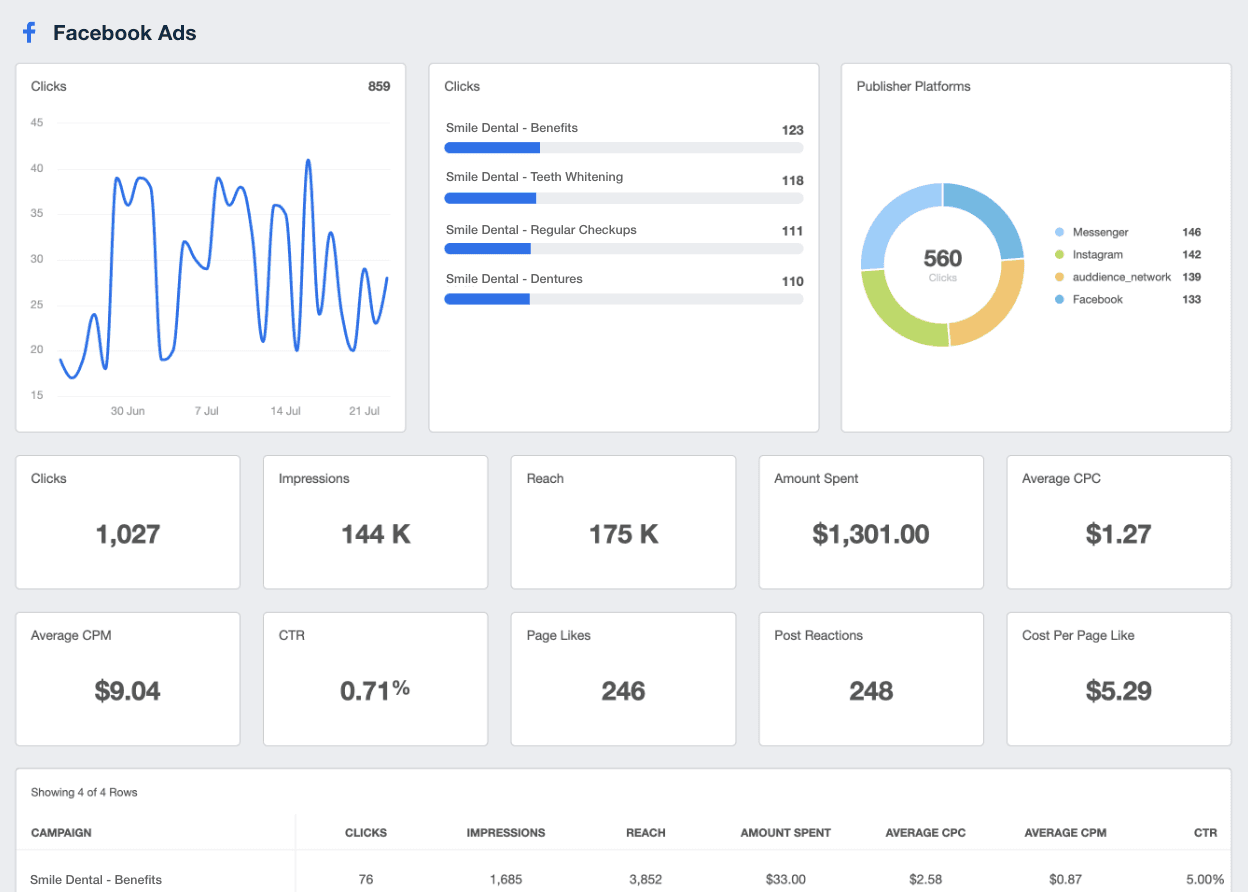
Want to impress your clients even more? Customize the dashboard to pull in their specific goals, like tracking leads or purchases, and showcase exactly how you’re driving ROI.
The best part? AgencyAnalytics offers client-ready reports that look sleek and professional. Add your branding and give clients data they can understand without wading through technical jargon.
Ready to save time, look great, and show off the results you’re driving? Try AgencyAnalytics and make Facebook Ad tracking effortless.
12 Facebook Ad Metrics You Should Track
The three groups we'll cover are the default column options in your Facebook Ads account. These are:
Performance Metrics
Delivery Metrics
Engagement Metrics
While these marketing metrics categories are helpful for every client campaign, some are more important than others to track performance, depending on your client's campaign goals.
For example, engagement rates are a much stronger KPI for a top-of-funnel content promotion campaign. Meanwhile, performance metrics are crucial to evaluate the success of a generation campaign.
Performance Metrics | Delivery Metrics | Engagement Metrics |
|---|---|---|
Results | ||
Cost per Result | ||
Result Rate (Conversion Rate) | Post Engagement | |
Custom Events & Conversions |
Performance Metrics
What business goals are you achieving, and how much is it costing your client?
1. Results
Results are the total number of times your campaign received its desired outcome.
This is arguably the most important metric, and will vary based on the type of Facebook Ads campaign, and the business goal you have set.
Results will typically be a conversion metric, such as website purchases or leads. However, if you're running a brand awareness campaign, you may have traffic or impressions as your target result rather than lead generation or sales.
Let's look at a few of the common types of Results for a campaign:
Website Purchases: Total number of purchases that occurred on your website.
Leads: Total number of Leads acquired on your website.
Form Leads: Facebook also offers "Lead Ads" that allow the user to submit their contact info (which is already pre-populated into the form fields) directly within the Facebook app. This result metric counts how many total form submissions occurred.
Custom Conversions (Downloads, Webinar Signups, etc.): You can track any event occurring on your website as a custom conversion using the Facebook Pixel. Downloads for an eBook, webinar signups or free trials are all possible "Results" you can track for your campaign as a custom conversion.
The specific result of your campaign is tracking will change depending on what you set as your target. Each campaign will list your result beneath the metric here:
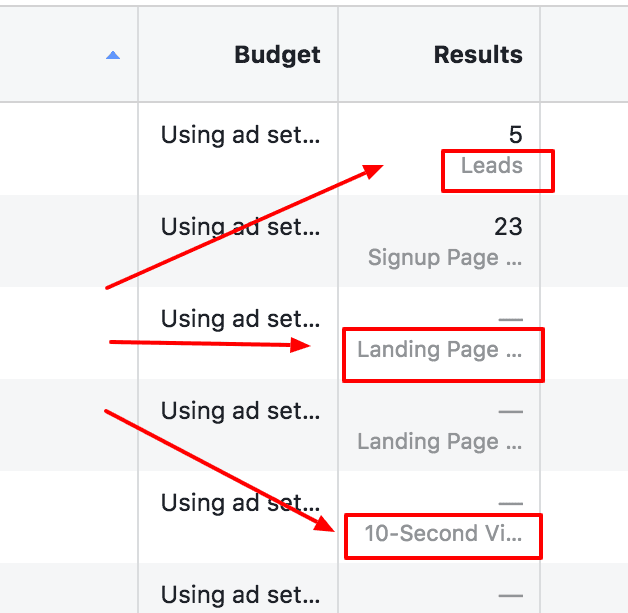
Otherwise, track custom conversions straight from your Facebook Ads dashboard:

2. Cost per Result
Cost per Result measures how much each desired result (or action) cost, and is measured by the formula: Total Ad Spend / Number of Results
On other PPC channels, this metric is most similar to "Cost Per Action" or CPA. The result (or action) for your campaign could be anything from a new signup, a sale, or a form submission, depending on your campaign's goals.
For example, the median Cost Per Lead for a Facebook Ads campaign current sits at $41.26, based on campaigns run by over 7,000 digital marketing agencies in December, 2024.

CPA is your most important Facebook Ads metric to measure the success of a campaign. CPA on Facebook Ads vary widely by industry on the type of conversion, and can range from $7.85 in the Education industry, to $55 in the Tech industry.
In this example, this campaign's desired action is App Activation, or how much it costs to have a new user download an app:

3. Result Rate (Conversion Rate)
Result Rate is the percentage of desired results you achieved compared to the total number of impressions.
Result rate is more commonly known as conversion rate across other digital advertising platforms when your "Result" is a lead or action.
The formula for your result rate is: # of Results / Impressions.
4. ROAS (Return on Ad Spend)
ROAS (Return on Ad Spend) is the amount of revenue the company receives for every $1 invested into ads, and is one of the key metrics to understand if you have a successful Facebook Ads campaign.
The formula to calculate ROAS is: Revenue / Ad Spend
If you're running an eCommerce campaign and tracking your sales with the Facebook Pixel, you can track ROAS directly in Facebook Ads. For other campaigns, this is something you'll have to calculate based on the conversion metric of each result achieved.

Alternatively, create custom metrics to calculate ROAS for Facebook Ads, and across all your other PPC campaigns. New to AgencyAnalytics? Start your free 14-day trial.
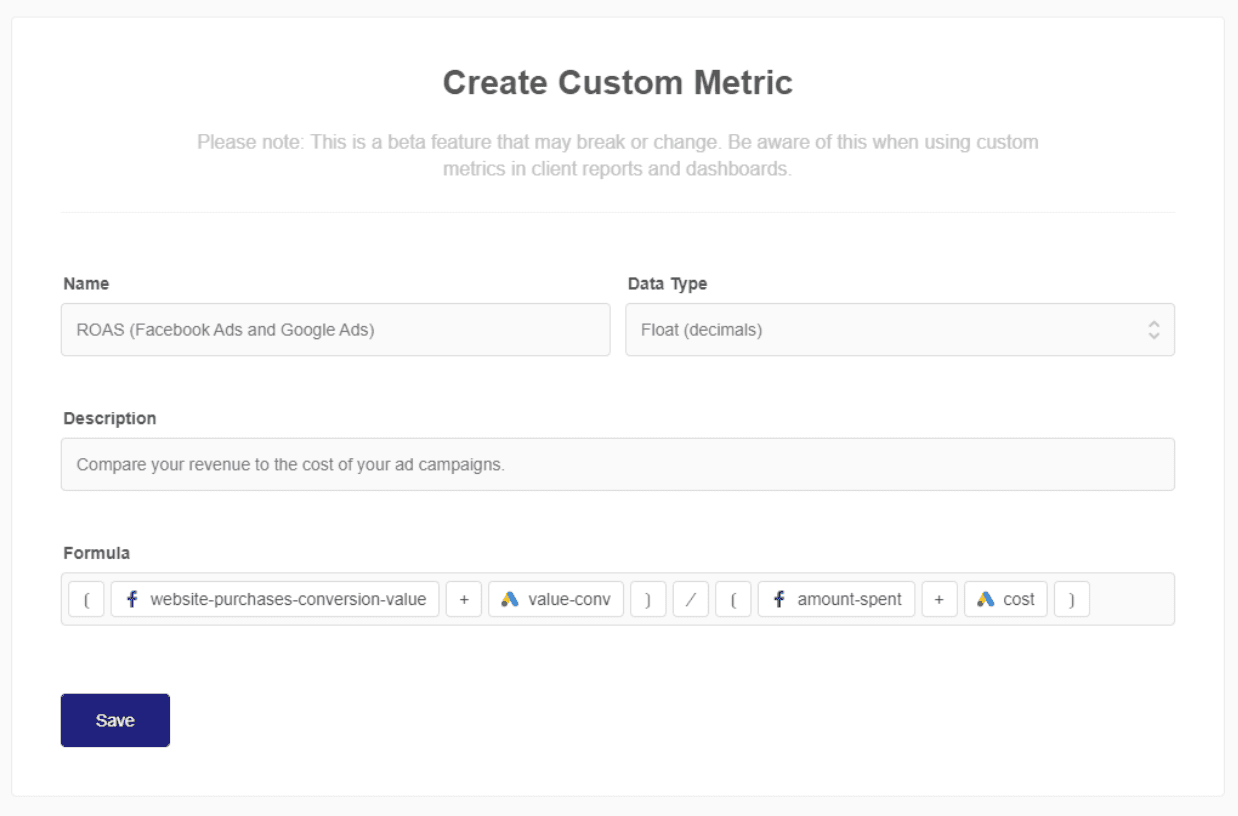
Delivery Metrics
How are your campaigns delivering what they promised? These Facebook Ads metrics measure how much it costs for your ads to be seen.
5. Spend
Spend is the total amount your ads cost for the selected time period.
This is one of the top metrics to include in a marketing client dashboard, so they can always monitor their PPC budget.
For reference, the median monthly spend for Facebook Ads across industries was $784.33 in December, 2024, making Facebook ad campaigns a staple for reaching target audiences on social media platforms.
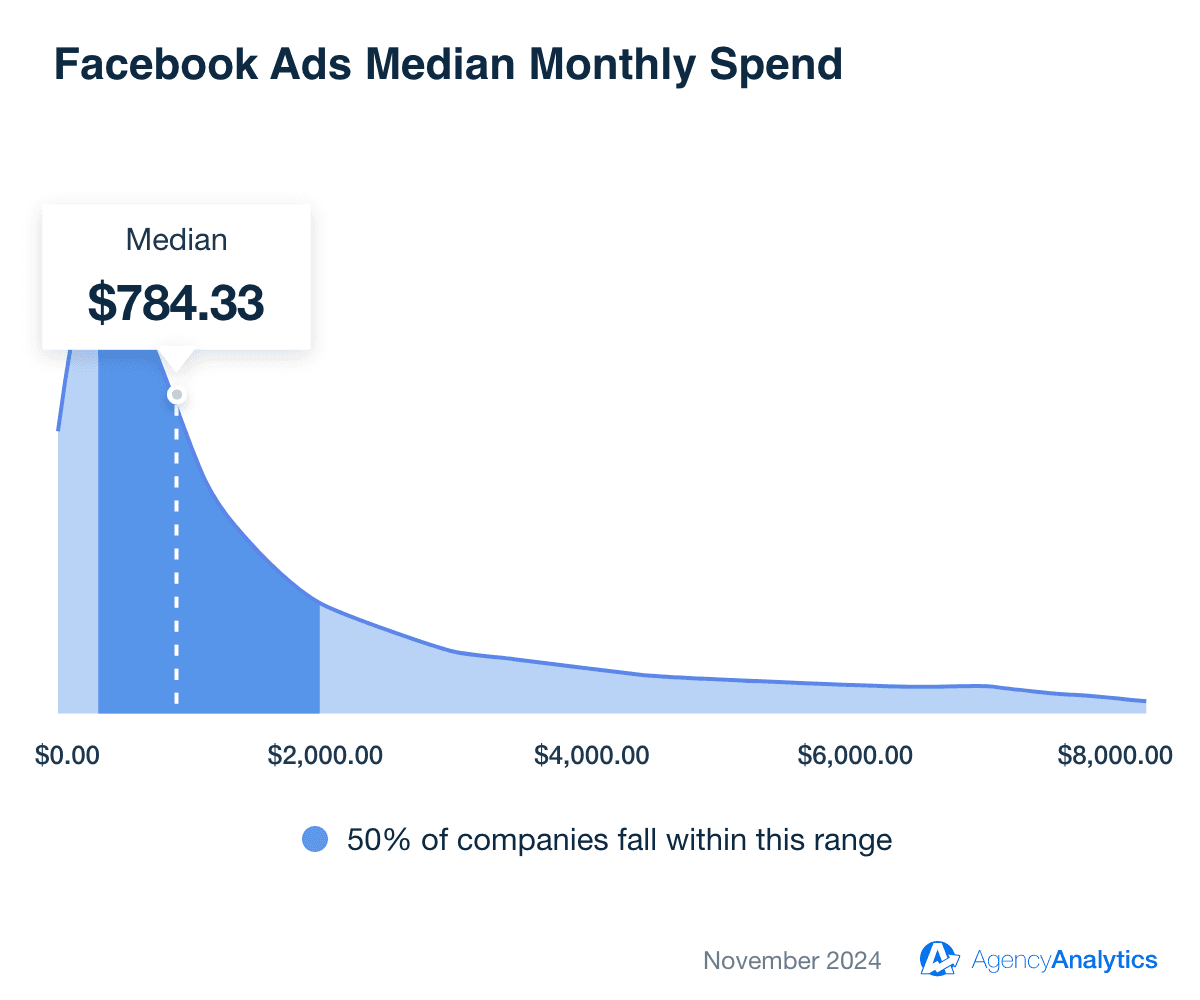
Keep in mind that monthly budget benchmarks will vary depending on the client's industry. For example, Apparel & Fashion brands have a median monthly Facebook Ads spend budget of $1,919.92.
It is necessary to keep an eye on spend to be sure you are within budget, but you also need to monitor other cost metrics (like Cost Per Result, Average CPC, and ROAS) to ensure you're generating positive returns.
For example, monitoring Facebook ads frequency not only helps avoid ad fatigue to ensure that your audience is not oversaturated with the same ads, but it can also reduce wasted spend beyond the point of diminishing returns.
6. Impressions
Impressions are the number of times your ads were on screen in front of your audience. The more impressions your ad receives, the higher your brand awareness is.
However, don't confuse Impressions with Reach:
Impressions are the total number of times your ad has been seen;
Reach is the total number of people who have seen your ad.
Let's say one person saw your ad 5 times. That means they got 5 Impressions, but only 1 Reach.
Facebook Ads is know for it's ability to reach a broad audience, why is why the average client campaign has a median reach of nearly 33,000 users each month, based on benchmark data from December, 2024.

You also want to look at impressions across publishing platforms to know where your ads are appearing most frequently.
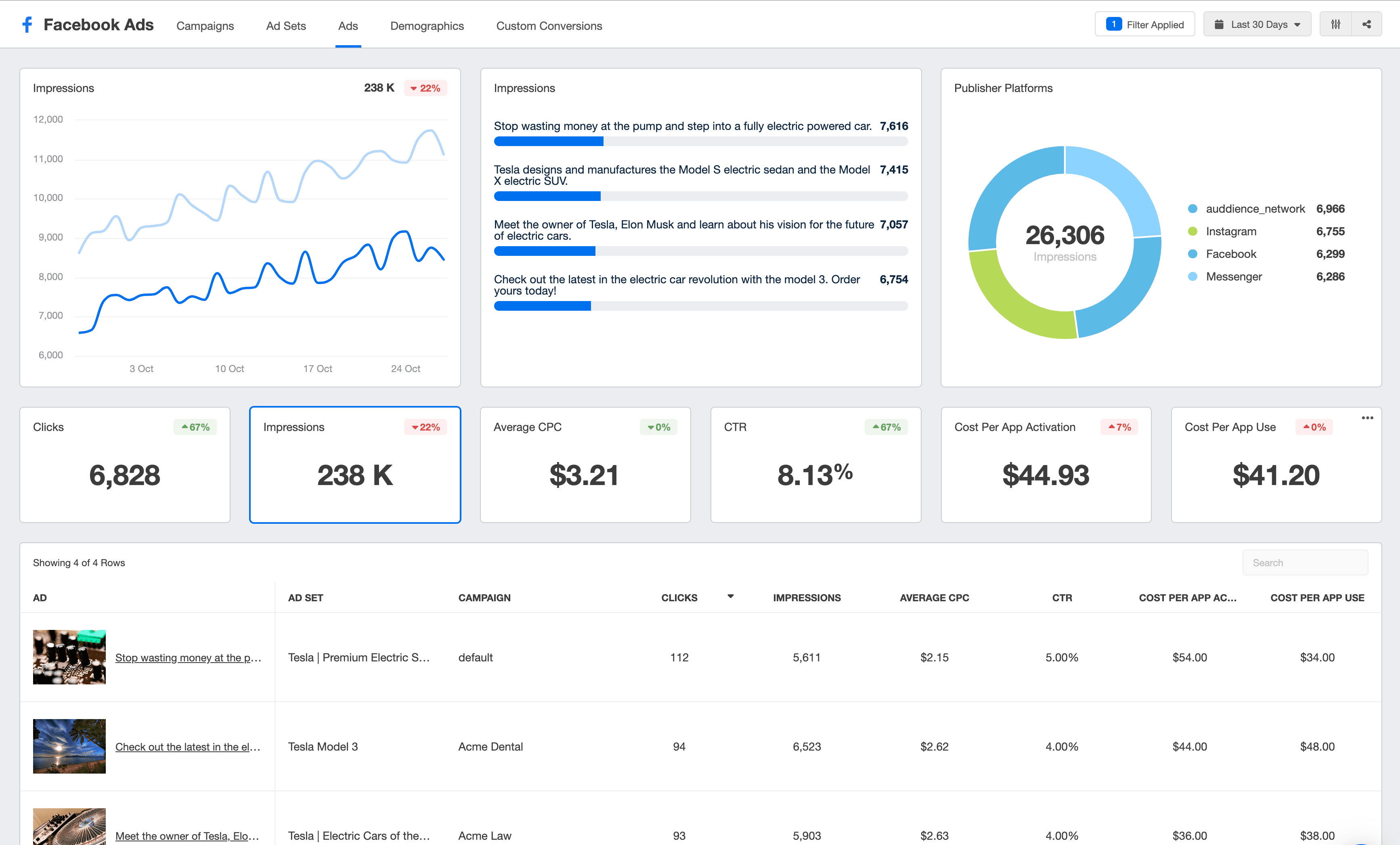
Track exactly which ad appears where straight from your Facebook Ads dashboard. New to AgencyAnalytics? Start your free 14-day trial.
7. CPM (Cost Per 1000 Impressions) or CPC
CPM (Cost per Mille) is the cost to achieve a thousand impressions.
CPM is a common metric across online advertising. It measures the cost-effectiveness of an ad campaign, and is a great metric to compare ad costs across different ad publishers and campaigns.
Cost per Click reflects the cost paid to achieve each click on Facebook Ads. In December, 2024 the media Cost Per Click for Facebook Ads campaigns, based on the AgencyAnalytics performance insights data, sat at $0.49.

It is also helpful in understanding how pricing is fluctuating for your chosen placement. Remember, Facebook Ads is an auction system. Is your CPA increasing because your target audience on the social media platform is becoming more competitive? Or is it because your conversion rates are plummeting?
Look at CPM and CPC within your client's Facebook ad campaigns to determine if it's the ad placement that is becoming more expensive, as well as compare ad cost across platforms.
8. Frequency
Frequency is the average number of times a person has seen your ad.
This is an especially important metric to measure if you have a very narrow, targeted audience.
While people often need to see an ad multiple times before converting, if they have seen an ad 10+ times, you're likely oversaturating your audience and need to expand your reach.
Keep an eye on frequency, but remember that ultimately if your conversion rate remains high, you probably aren't oversaturating your audience yet.
Engagement Metrics
These look at how well your ad creative appeals to your audience.
9. Clicks
Link clicks are the total number of times people have clicked your ad's link.
The first step to an exceptional Facebook Ads campaign is to confirm that your ad is being delivered by looking at impressions.
Next, you need to confirm that your ad is engaging. If no one is interacting with your ad, you're not going to achieve conversions.
A typical Facebook Ads client campaign can achieve a media number of clicks that exceeds 1,500 per month, based on recent Facebook Ads performance benchmarks.

Clicks are one of the key Facebook ad metrics to confirm that your target audience is actually interested in your offer.
When you log in to your Facebook Ads Manager account, you will see a few different basic metrics related to "Clicks". The most important one to pay attention to will be Clicks (Link). After all, these are the clicks that are going to lead to conversions! One of the options you'll also see is "Clicks (All)". This is counting all clicks on your ad, including clicks over to your Facebook page or other click interactions with your ad.
While "Clicks (All)" does indicate engagement with your ad, it's not the engagement that is going to lead to your next conversion. So you typically want to prioritize Clicks (Links) in your Facebook Ads reporting tool.
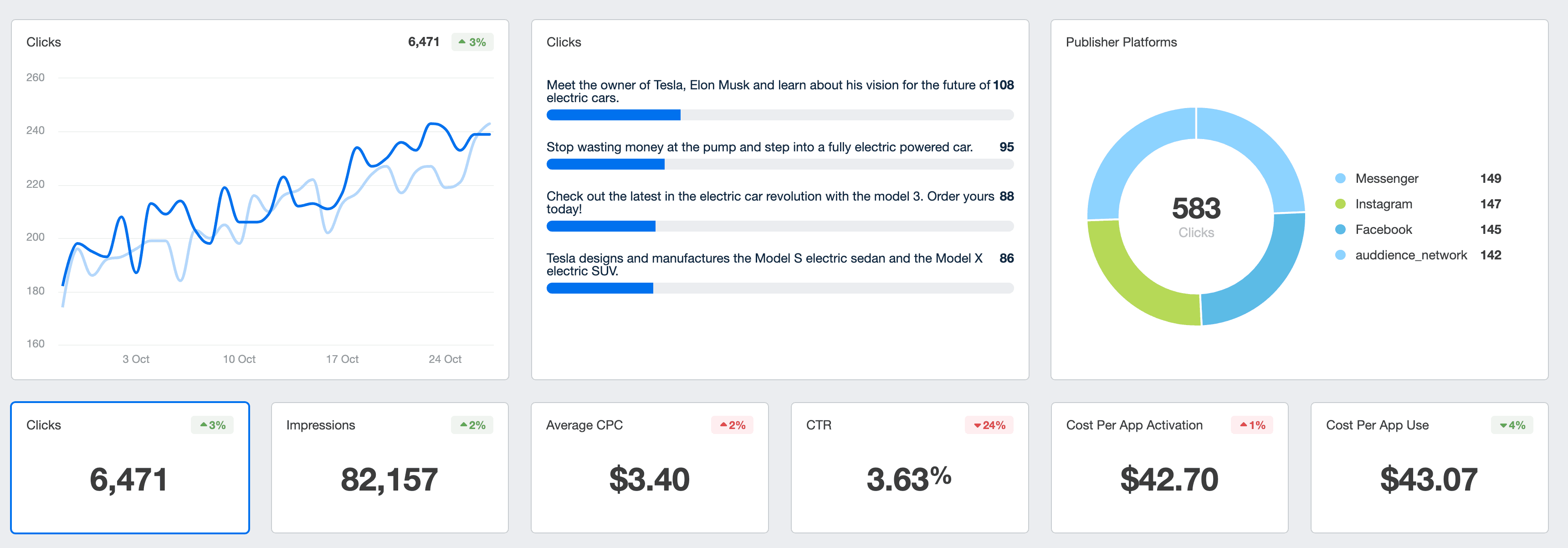
Calculate Clicks at the Campaign, Ad set, or Ad level in your AgencyAnalytics dashboard. Start your free 14-day trial today!
10. CTR (Click-through Rate)
CTR (Click-through Rate) is the number of clicks compared to the number of impressions.
You may see 100 clicks and think your ads perform well. However, if your total number of impressions is 100,000 then those 100 clicks won't seem as impressive anymore.
This is where click-through rates comes into your Facebook Ad reports. CTR is calculated by dividing total clicks by impressions. In our above example, an ad that received 100 clicks and 100,000 impressions has a low CTR of 0.1% However, if the total number of impressions was 1,000, that is a CTR of 10%.
You can't look at clicks alone—you must compare it to impressions to really evaluate how engaging your ads are.
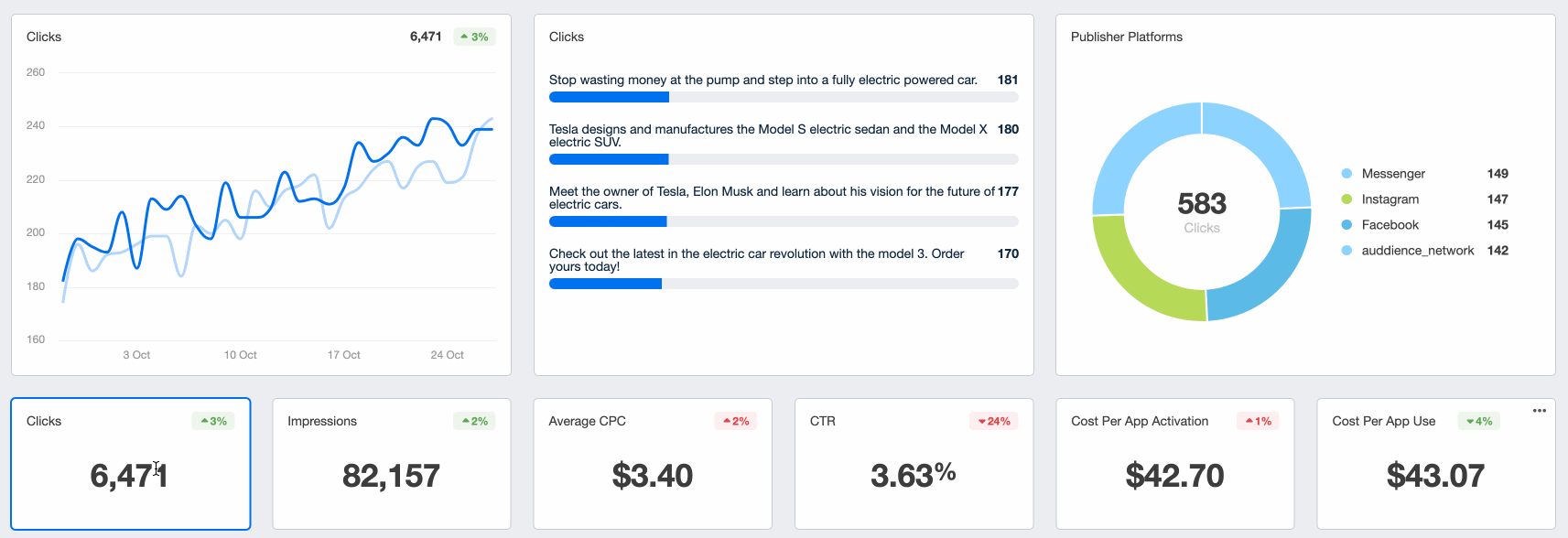
For reference, based on data from over 150,000 campaigns run by professional marketing agencies, the Facebook Ads median CTR in November of 2024 was 1.77%.

Agencies working with the Facebook Ad CTR benchmark often examine creative quality, audience segmentation, and ad formats to maintain or improve performance. Campaigns below 1.77% might need updated visuals or more precise targeting.
While engagement may not be as high as Google Ads, Facebook’s targeting tools allow campaigns to connect with specific groups effectively. Tracking all this in a live dashboard makes it easy to compare between Facebook Ads metrics and spot trends. New to AgencyAnalytics? Start your free 14-day trial.
11. Post Engagement
Post Engagement is the total number of reactions, shares, comments, and clicks that your post received.
If you're A/B testing multiple different ad types, post engagement and CTR are two of your most important metrics to determine how well that specific ad appeals to your target audiences.
You can also choose to look specifically at "Post Comments" and "Post Reactions" to break out the different engagement types. But for a full picture of how often people are engaging with your post, select "Post Engagement."
12. Custom Events & Conversions
Tracking custom events and conversions is where Facebook Ads can truly shine. These metrics go beyond standard clicks and impressions, allowing you to measure specific actions that matter most to your clients—like sign-ups, purchases, or even time spent on a key page.

By setting up custom events, you tailor reports and dashboards to your clients’ unique goals, ensuring you’re capturing data that tells the full story of their campaigns. For example, if a client runs an e-commerce store, you can track when someone adds an item to their cart or completes a checkout. These insights help paint a detailed picture of the buyer’s journey and pinpoint areas to optimize.
How Agencies Should Track Facebook Ads Metrics
Of course, Facebook Ads metrics are available in each of your clients' Facebook Ads Business Manager accounts. There, you can customize your columns to find a full list of the metrics available, determine the most important metrics for your campaigns, and save them as a preset in the bottom left corner.
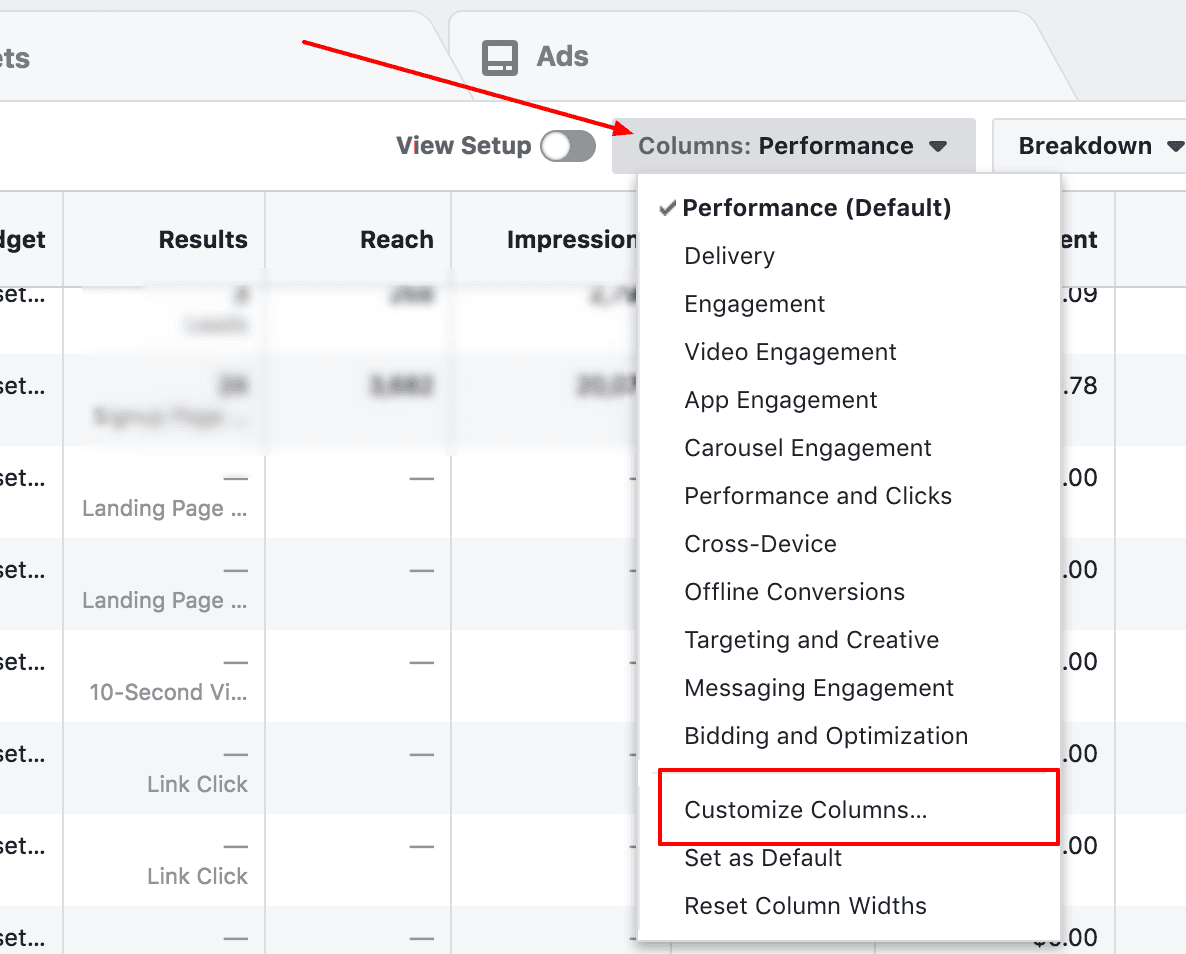
Alternatively, use the option chosen by 7,000 agencies: use an automated client reporting platform to bring in all your clients' Facebook Ads metrics into one place. This makes it easy to visualize Facebook Ads metrics in real-time, for every one of your clients, at scale, and save billable hours with a professional Facebook Ads report template.
Adding any of the metrics mentioned in this article into live dashboards gives you quick, actionable insights into each client's Facebook Ads campaign performance. Without logging in and out of multiple accounts.
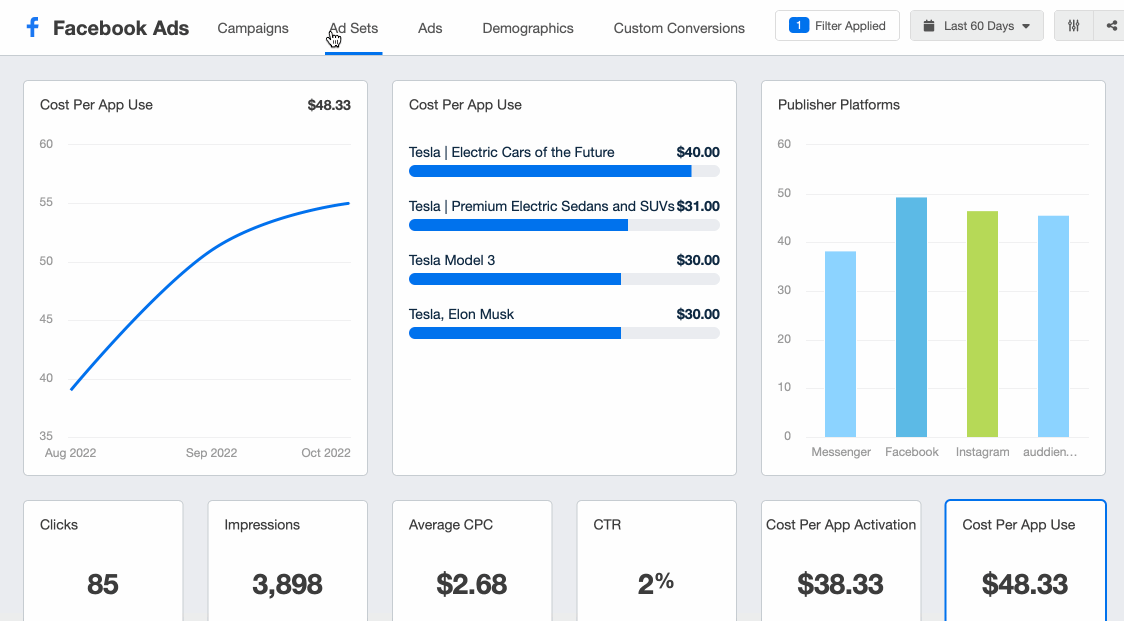
Your top metrics are already included in the customizable Facebook Ads dashboard template.
Impress clients and save hours with custom, automated reporting.
Join 7,000+ agencies that create reports in under 30 minutes per client using AgencyAnalytics. Get started for free. No credit card required.
What Makes a Great Facebook Ads Report?
1. Integrating Facebook Ads with All of Your Clients’ Other Campaign Metrics
By integrating Facebook Ads with the other tools your client is using, you get a complete picture of how their campaigns are performing and where they need to improve. Rather than looking at Facebook Ads metrics in isolation, compare them to Google Analytics data to provide a more complete picture.
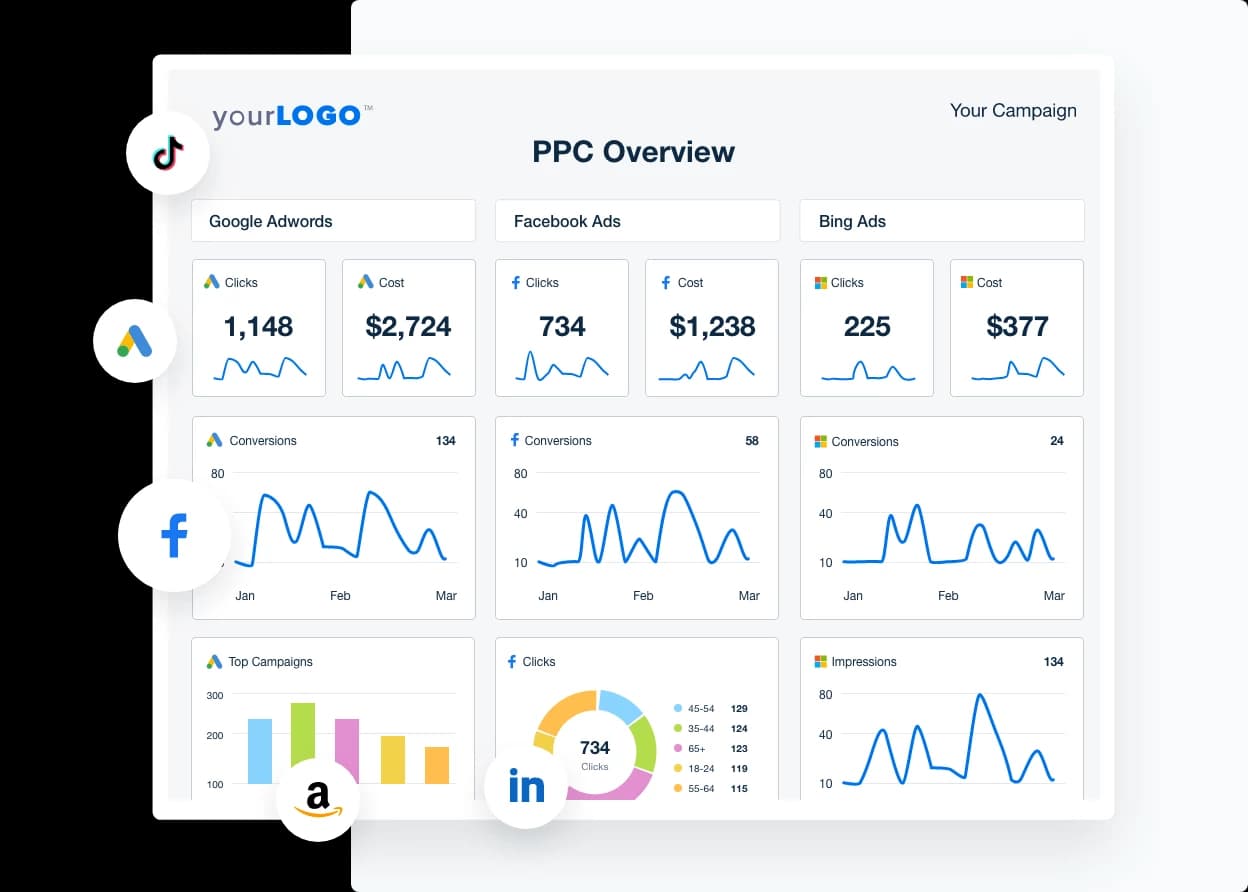
Use our PPC reporting tool to combine your Facebook Ads data with your other key marketing channels. Or create a professional report using a customizable PPC report template.
2. Tracking the Right Facebook Ads Metrics
Not all of the 350+ metrics in Facebook Ads Manager are relevant to every campaign. By tracking only the most important metrics, you save time and avoid overwhelming your client with too much data. Creating a Facebook Ads dashboard keeps your clients from getting buried under data.

Access your Facebook insights, monitor ad performance, and manage engagement for all your clients with our Facebook Ads dashboard template.
3. Focusing on the Results That Matter
Your clients are ultimately interested in results, not ad metrics. Use goals and custom metrics to show clients exactly how your Facebook Ads campaigns are contributing to their success.
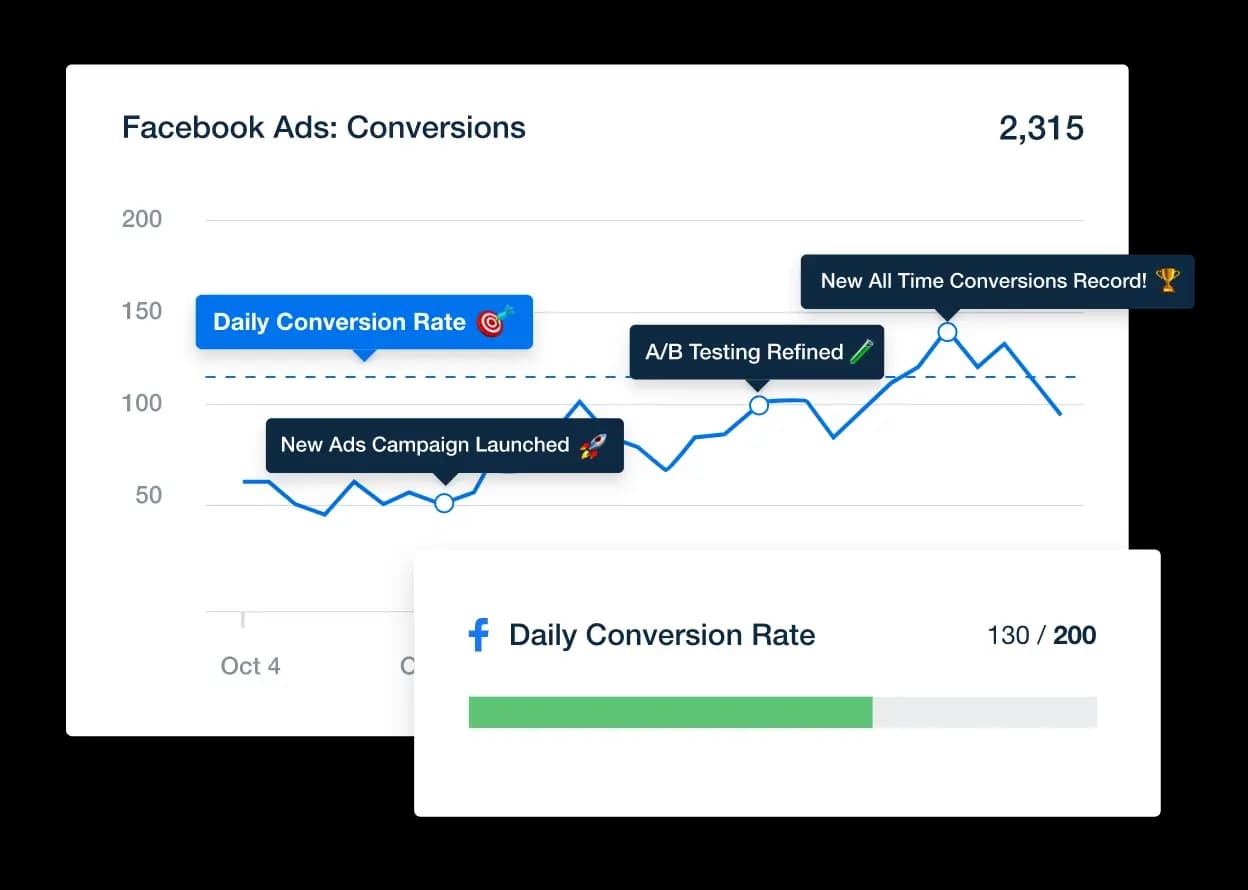
Incorporate data storytelling into your client reports to better. Explain your results with Goals and Annotations to add that personal touch your clients will appreciate.
4. Using Automated Reporting Tools
Automated client reporting tools can save you hours of time by collecting and organizing all of the relevant data for you. Set up exactly the Facebook Ads metrics your clients need to see, and then that data will automatically populate each KPI reporting cycle. Create beautiful, consistent client reports that leave no room for human error.
Streamline Your Facebook Ads Metrics Reporting With AgencyAnalytics
Leveraging the power of Facebook Ads requires a nuanced understanding of how Facebook tracks user interactions. By focusing on the right metrics, advertisers can align their strategies with the objectives set for each Facebook Ad campaign, ensuring they reach their audience at the right moment for a good time to engage.
This approach is essential for targeting the average user effectively and driving high conversions. Keeping a close eye on these metrics ensures that your campaigns are constantly fine-tuned to meet your goals.
It's easy to get bogged down in all of the options available in Facebook Ads Manager. However, if you just look at these 11 metrics, you'll be on your way to better optimized, better performing campaigns.
Understanding your most important Facebook Ads metrics is the key to boosting the return on investment (ROI) of your campaigns. Communicating them in a clear way is key to client retention.
But even after narrowing down each clients' KPIs and metrics, the more clients you have, the longer it takes to regularly monitor their campaign metrics to create client reports or KPI dashboards. Unless you have the right tools.

Bring all your clients’ key Facebook Ads metrics into one place–and include them alongside your other PPC campaigns!
FAQs About Facebook Ads Metrics
Looking for more insights into Facebook Ads metrics? We’ve got you covered.
When running Facebook ads, agencies should categorize metrics into five key types. This structure simplifies reporting, filters out noise, and helps clients see how Facebook ad performance aligns with their business goals.
Performance Metrics: Measure how effectively ads achieve desired outcomes such as conversions, sales, or leads. Key metrics include conversion rate, cost per action (CPA), return on ad spend (ROAS), and cost per conversion. These are the clearest indicators of profitability and campaign success.
Delivery Metrics: Reveal how ads are served and distributed to the audience. Important metrics include impressions, CPM (cost per 1,000 impressions), reach, and ad frequency. They help you understand whether the campaign is reaching enough people at a sustainable advertising cost.
Engagement Metrics: Track how users interact with ad content. Focus on click-through rate (CTR), post engagement, reactions, comments, and shares. These metrics show audience engagement and are strong indicators of ad relevance and creative effectiveness.
Video Metrics: Measure how users interact with video ads across placements. Look at video views, view-through rate (VTR), average watch time, and cost per view (CPV). These provide insight into how compelling your ad content is in the feed or audience network.
Other Metrics: Include relevance score (now “quality ranking”), ad placement performance, and audience network data. These reveal qualitative insights about ad quality, placement efficiency, and how different environments affect performance.
By grouping your Facebook ads metrics list this way, you create a focused reporting structure that highlights what truly drives outcomes—allowing agencies to make smarter, data-driven optimizations for better ads.
The best KPIs for Facebook ads vary by campaign objective, but typically include Click‑through rate (CTR), Cost per click (CPC), Cost per acquisition (CPA), Return on ad spend (ROAS), and Conversion rate. For awareness campaigns you might prioritize CPM and reach; for lead generation you’ll track cost per lead and conversions.
It’s important to align the Facebook ads KPIs with overall client goals — target audience size, budget limits, high quality leads vs volume — rather than chasing every metric in the dashboard. This targeted approach prevents vanity metric distractions and ensures your agency’s reporting drives strategic actions.
CTR and post engagement show whether your client’s audience is clicking, reacting, or commenting on ads. High engagement means the messaging and creative are working. Low numbers suggest the need to change the visuals, copy, or targeting. These metrics guide ad adjustments that improve conversions and help clients reach campaign goals faster.
In addition to CTR and engagement, you should monitor the ad frequency and ad quality (or relevance score) of your campaigns. A high frequency might mean your audience is seeing the same ad too often, which can inflate engagement numbers yet actually erode performance over time.
Similarly, if user reactions or comments skew negative, the relevance score may dip, suggesting your ad content or targeting isn’t resonating. Use a comprehensive list of Facebook Ads performance metrics — including these secondary indicators — to spot declining ad health early and optimize before cost per click (CPC) and conversion rate suffer.
AgencyAnalytics centralizes Facebook ad metrics in one dashboard. There’s also the option to create login profiles, which gives clients on-demand access to real-time data. Additionally, agencies can easily deliver professionally designed, white labeled, and fully customizable reports–all with one tool.
Another layer to consider is how you present Facebook Ads key metrics and integrate them with data from other channels. Beyond a dedicated dashboard for Facebook data, it’s valuable to pull in ad impressions, click-through rate (CTR), campaign view data, and audience network placement insights (or similar) from other channels into a unified, client‑ready report.
This holistic view helps clients understand how Facebook Ads fit into their broader digital marketing mix, rather than existing in isolation. Choosing a tool that supports exportable charts, automated scheduling, and white-label branding enables you to scale reporting efficiently while maintaining focus on meaningful insights, rather than just raw numbers.
A Facebook ad is performing well when it meets or exceeds industry benchmark values for CPC, CTR, CPA, and ROAS based on your client’s industry and funnel stage. For instance, a high CTR paired with low conversions might hint at ad copy or landing page issues despite good engagement. Conversely, low frequency and high relevance score with above‑average ROAS suggests optimal targeting and creative.
Review ad quality, ad frequency, and placement breakdown in addition to the headline KPIs. When your reporting consistently shows improvements in these areas, you have strong evidence of better ads, enhanced performance, and a campaign aligned with your client’s business goals.
Impressions show how often ads are seen. On the other hand, CPM shows how much it costs to reach 1,000 views. These metrics reveal whether the ad spend is reaching the right audience at a sustainable cost.
While impressions and CPM (cost per 1,000 impressions) are foundational delivery metrics, it’s equally important to cross‑reference ad frequency, ad content variation, and placement performance (e.g., News Feed vs Audience Network).
A campaign with low CPM but high frequency may be oversaturating the same audience, raising the risk of declining effectiveness. Monitoring the ratio of impressions to reach provides insight into how many unique users saw your ad versus repeat views — a key indicator of healthy campaign delivery. When you account for delivery hiccups, you’re better positioned to adjust bidding strategies and placements for optimal cost-effectiveness.
Vanity metrics are numbers that look impressive but don’t link to meaningful business outcomes or ad success. In Facebook Ads, examples include video views without duration context, likes that don’t lead to clicks or conversions, and reach or impressions unaccompanied by engagement or actions.
Such metrics may inflate perceived performance but fail to drive ROI or revenue. Agencies should steer clients away from focusing on these alone, and instead prioritize metrics like conversion rate, ROAS, and cost per acquisition. This ensures that you’re reporting on what truly matters — better ads that align with client goals, not just surface‑level metrics.
ROAS quantifies the revenue returned for every dollar spent. High ROAS confirms campaign profitability, while low ROAS highlights inefficiencies (e.g., poor audience targeting, weak ad creative, or an underperforming landing page). It’s the clearest way to show clients whether ads are worth the investment.
Beyond the basic ROAS (return on ad spend) metric, agencies should tie ROAS back to specific campaign view insights—such as which placements, creatives or audiences contributed most to high‑return ads. Segmenting ROAS by variable groups (e.g., video ads vs static images) uncovers where your budget delivers the most value.
Additionally, compare ROAS against ad acquisition cost, lifetime value of customers, and cross‑platform attribution to ensure your Facebook Ads performance isn’t artificially inflated. Tracking this deeper-level data empowers you to make smarter decisions and clearly demonstrate to clients where their advertising investment is making (or losing) money.
Custom conversions track the exact actions clients care about, like purchases, form submissions, downloads, or signups. They add a layer of specificity and align reporting with tangible business outcomes.
Custom conversions are powerful—but they’re most effective when paired with proper setup, domain verification, and consistent tagging across your site or app. By assigning unique conversion events for actions like “newsletter signup,” “add to cart,” or “checkout completed,” you enrich your Facebook ads analytics with business‑relevant behavior.
This approach enables you to identify the ad sets with the highest conversion rate and refine the audience targeting accordingly. For agencies, delivering this level of specificity strengthens your value proposition: you’re not just delivering clicks, you’re optimizing for the actions that contribute to client revenue and enabling richer ad reporting and actionable insights.

Written by
Melody Sinclair-Brooks brings nearly a decade of experience in marketing in the tech industry. Specializing in B2B messaging for startups and SaaS, she crafts campaigns that cut through the noise, leveraging customer insights and multichannel strategies for tangible growth.
Read more posts by Melody Sinclair-BrooksSee how 7,000+ marketing agencies help clients win
Free 14-day trial. No credit card required.



